Critical Analysis: Management Theories and Organizational Impact
VerifiedAdded on 2020/05/04
|12
|2670
|43
Essay
AI Summary
This essay provides a critical analysis of various management theories, including deterministic and strategic choice theories, and their impact on organizational structure and decision-making. It explores how strategic choice theory considers both internal and external factors, offering a comprehensive approach to management. The essay also examines deterministic theories, such as resource dependence and institutional theories, and their influence on organizational behavior. Furthermore, it discusses the population theory and its implications. The student argues that the strategic choice theory is most compelling due to its comprehensive approach, ultimately highlighting the importance of effective management in achieving organizational goals. The essay emphasizes the role of both internal and external factors in shaping organizational decisions and driving progress.
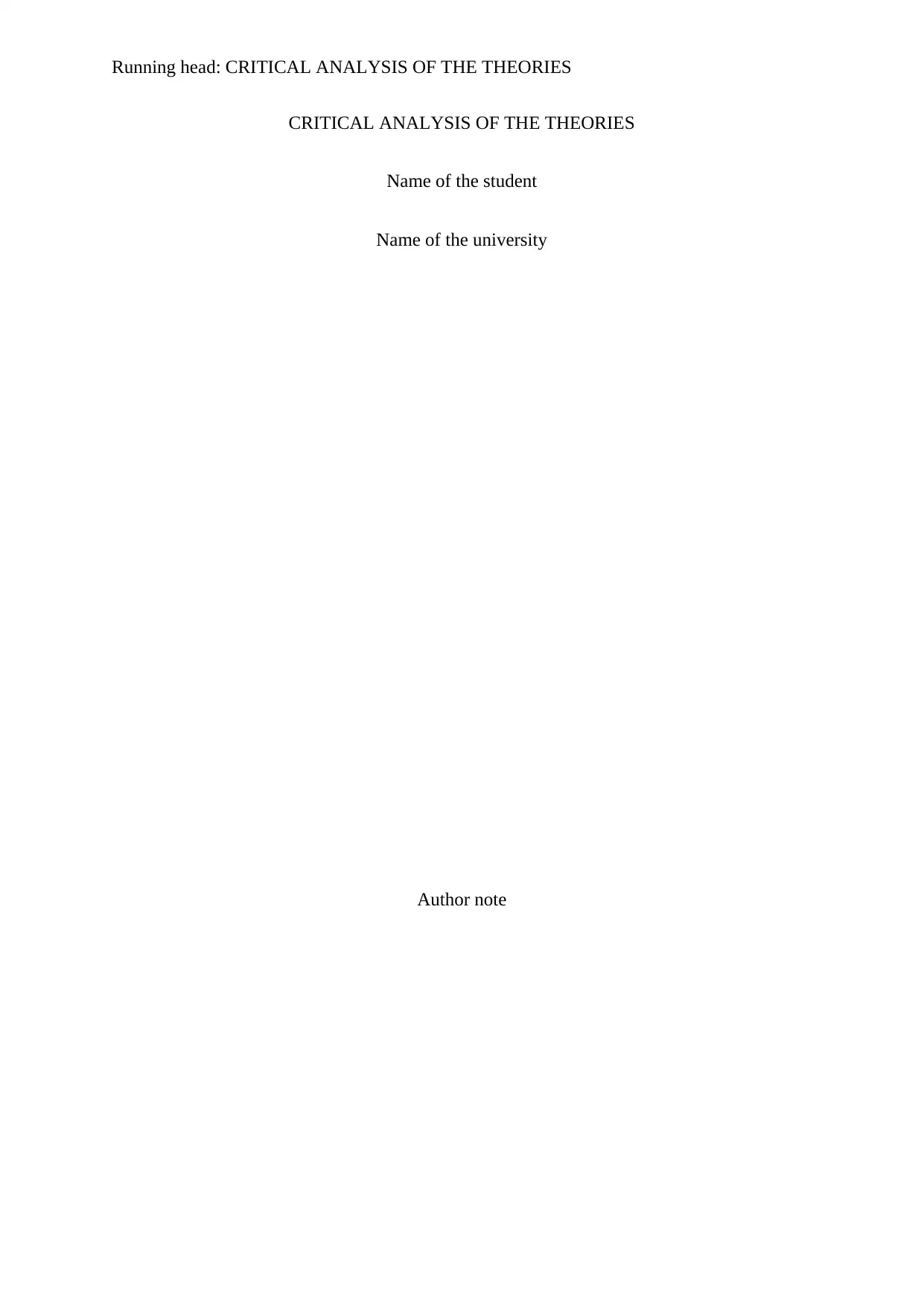
Running head: CRITICAL ANALYSIS OF THE THEORIES
CRITICAL ANALYSIS OF THE THEORIES
Name of the student
Name of the university
Author note
CRITICAL ANALYSIS OF THE THEORIES
Name of the student
Name of the university
Author note
Paraphrase This Document
Need a fresh take? Get an instant paraphrase of this document with our AI Paraphraser
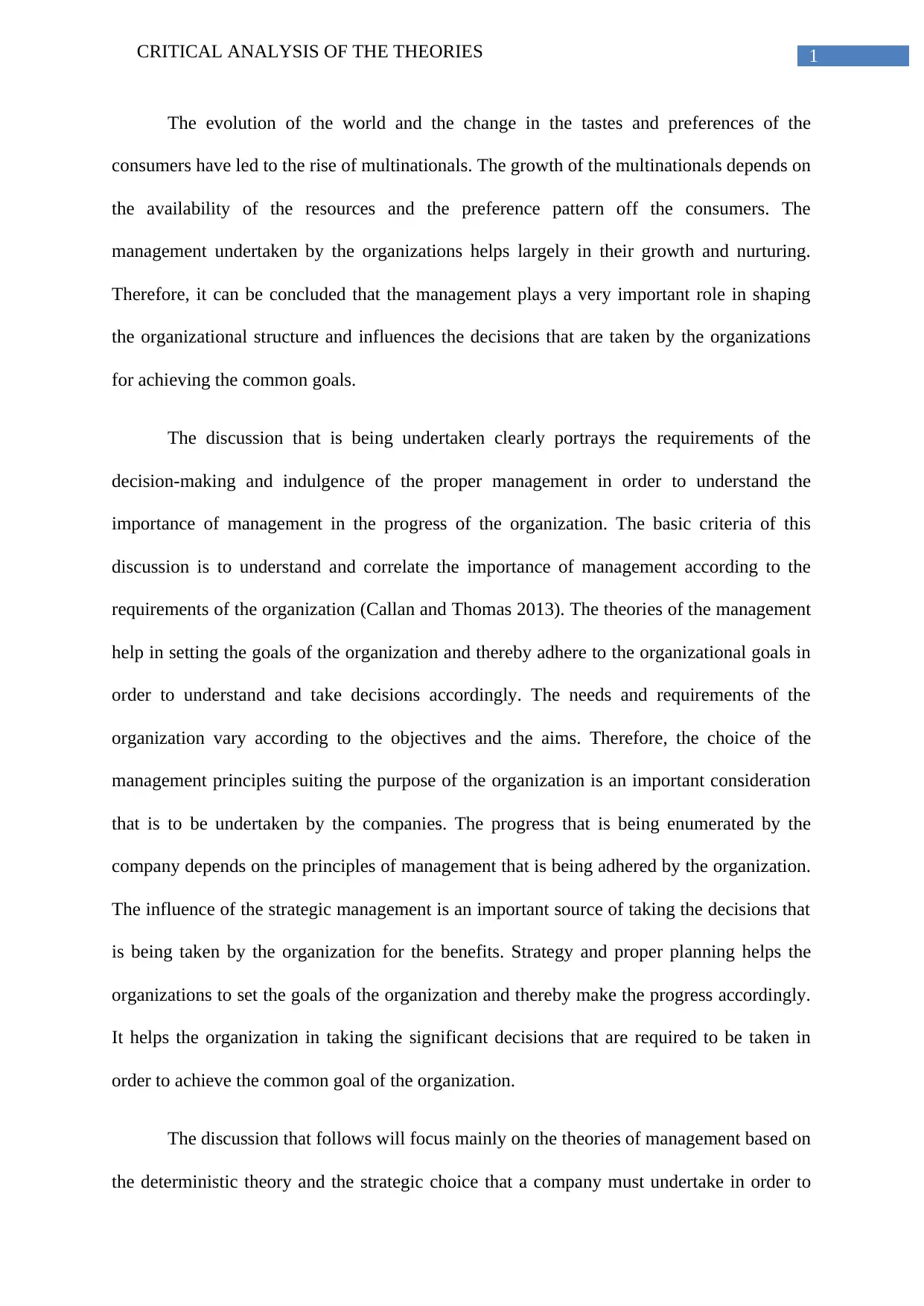
1CRITICAL ANALYSIS OF THE THEORIES
The evolution of the world and the change in the tastes and preferences of the
consumers have led to the rise of multinationals. The growth of the multinationals depends on
the availability of the resources and the preference pattern off the consumers. The
management undertaken by the organizations helps largely in their growth and nurturing.
Therefore, it can be concluded that the management plays a very important role in shaping
the organizational structure and influences the decisions that are taken by the organizations
for achieving the common goals.
The discussion that is being undertaken clearly portrays the requirements of the
decision-making and indulgence of the proper management in order to understand the
importance of management in the progress of the organization. The basic criteria of this
discussion is to understand and correlate the importance of management according to the
requirements of the organization (Callan and Thomas 2013). The theories of the management
help in setting the goals of the organization and thereby adhere to the organizational goals in
order to understand and take decisions accordingly. The needs and requirements of the
organization vary according to the objectives and the aims. Therefore, the choice of the
management principles suiting the purpose of the organization is an important consideration
that is to be undertaken by the companies. The progress that is being enumerated by the
company depends on the principles of management that is being adhered by the organization.
The influence of the strategic management is an important source of taking the decisions that
is being taken by the organization for the benefits. Strategy and proper planning helps the
organizations to set the goals of the organization and thereby make the progress accordingly.
It helps the organization in taking the significant decisions that are required to be taken in
order to achieve the common goal of the organization.
The discussion that follows will focus mainly on the theories of management based on
the deterministic theory and the strategic choice that a company must undertake in order to
The evolution of the world and the change in the tastes and preferences of the
consumers have led to the rise of multinationals. The growth of the multinationals depends on
the availability of the resources and the preference pattern off the consumers. The
management undertaken by the organizations helps largely in their growth and nurturing.
Therefore, it can be concluded that the management plays a very important role in shaping
the organizational structure and influences the decisions that are taken by the organizations
for achieving the common goals.
The discussion that is being undertaken clearly portrays the requirements of the
decision-making and indulgence of the proper management in order to understand the
importance of management in the progress of the organization. The basic criteria of this
discussion is to understand and correlate the importance of management according to the
requirements of the organization (Callan and Thomas 2013). The theories of the management
help in setting the goals of the organization and thereby adhere to the organizational goals in
order to understand and take decisions accordingly. The needs and requirements of the
organization vary according to the objectives and the aims. Therefore, the choice of the
management principles suiting the purpose of the organization is an important consideration
that is to be undertaken by the companies. The progress that is being enumerated by the
company depends on the principles of management that is being adhered by the organization.
The influence of the strategic management is an important source of taking the decisions that
is being taken by the organization for the benefits. Strategy and proper planning helps the
organizations to set the goals of the organization and thereby make the progress accordingly.
It helps the organization in taking the significant decisions that are required to be taken in
order to achieve the common goal of the organization.
The discussion that follows will focus mainly on the theories of management based on
the deterministic theory and the strategic choice that a company must undertake in order to
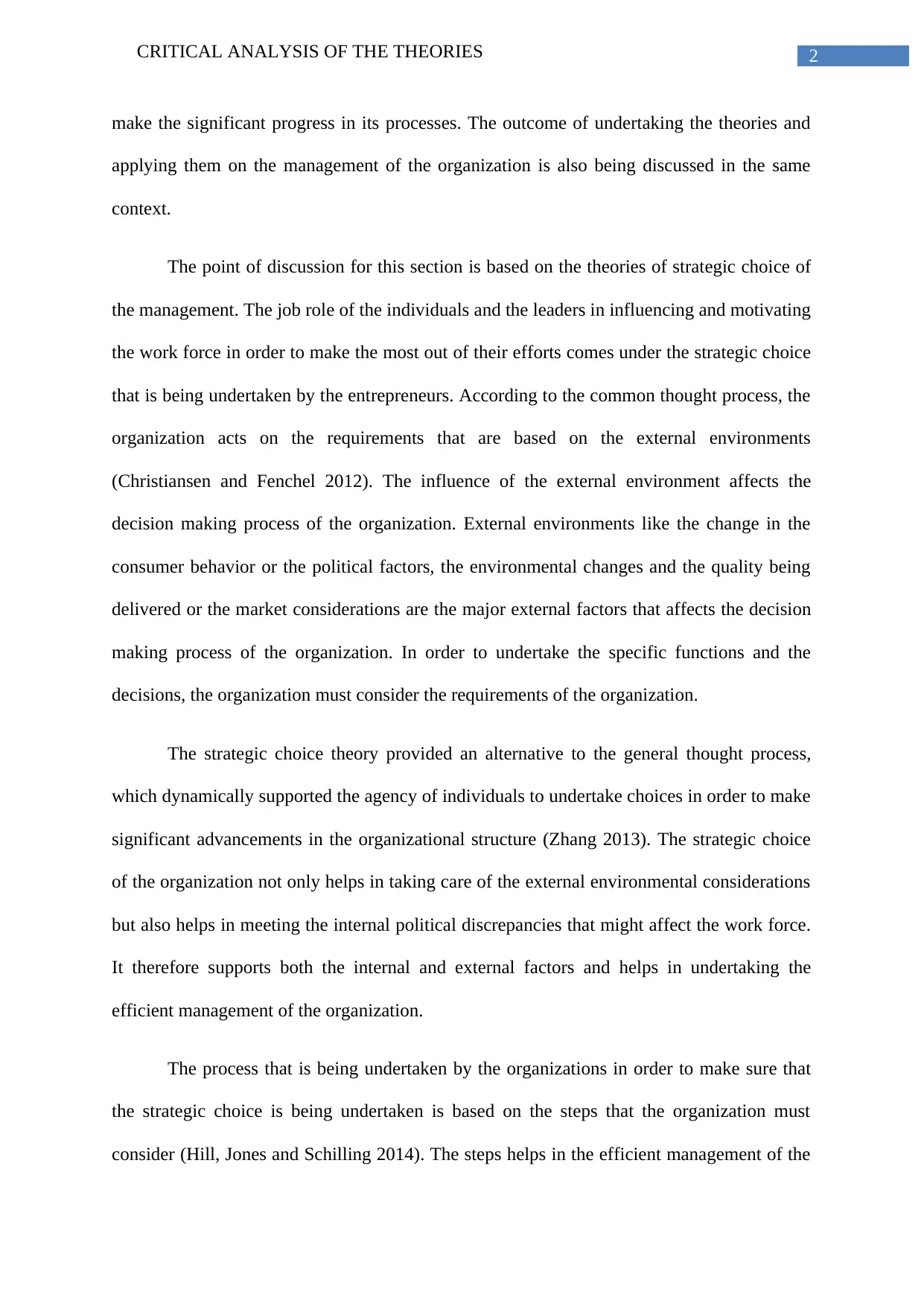
2CRITICAL ANALYSIS OF THE THEORIES
make the significant progress in its processes. The outcome of undertaking the theories and
applying them on the management of the organization is also being discussed in the same
context.
The point of discussion for this section is based on the theories of strategic choice of
the management. The job role of the individuals and the leaders in influencing and motivating
the work force in order to make the most out of their efforts comes under the strategic choice
that is being undertaken by the entrepreneurs. According to the common thought process, the
organization acts on the requirements that are based on the external environments
(Christiansen and Fenchel 2012). The influence of the external environment affects the
decision making process of the organization. External environments like the change in the
consumer behavior or the political factors, the environmental changes and the quality being
delivered or the market considerations are the major external factors that affects the decision
making process of the organization. In order to undertake the specific functions and the
decisions, the organization must consider the requirements of the organization.
The strategic choice theory provided an alternative to the general thought process,
which dynamically supported the agency of individuals to undertake choices in order to make
significant advancements in the organizational structure (Zhang 2013). The strategic choice
of the organization not only helps in taking care of the external environmental considerations
but also helps in meeting the internal political discrepancies that might affect the work force.
It therefore supports both the internal and external factors and helps in undertaking the
efficient management of the organization.
The process that is being undertaken by the organizations in order to make sure that
the strategic choice is being undertaken is based on the steps that the organization must
consider (Hill, Jones and Schilling 2014). The steps helps in the efficient management of the
make the significant progress in its processes. The outcome of undertaking the theories and
applying them on the management of the organization is also being discussed in the same
context.
The point of discussion for this section is based on the theories of strategic choice of
the management. The job role of the individuals and the leaders in influencing and motivating
the work force in order to make the most out of their efforts comes under the strategic choice
that is being undertaken by the entrepreneurs. According to the common thought process, the
organization acts on the requirements that are based on the external environments
(Christiansen and Fenchel 2012). The influence of the external environment affects the
decision making process of the organization. External environments like the change in the
consumer behavior or the political factors, the environmental changes and the quality being
delivered or the market considerations are the major external factors that affects the decision
making process of the organization. In order to undertake the specific functions and the
decisions, the organization must consider the requirements of the organization.
The strategic choice theory provided an alternative to the general thought process,
which dynamically supported the agency of individuals to undertake choices in order to make
significant advancements in the organizational structure (Zhang 2013). The strategic choice
of the organization not only helps in taking care of the external environmental considerations
but also helps in meeting the internal political discrepancies that might affect the work force.
It therefore supports both the internal and external factors and helps in undertaking the
efficient management of the organization.
The process that is being undertaken by the organizations in order to make sure that
the strategic choice is being undertaken is based on the steps that the organization must
consider (Hill, Jones and Schilling 2014). The steps helps in the efficient management of the
⊘ This is a preview!⊘
Do you want full access?
Subscribe today to unlock all pages.

Trusted by 1+ million students worldwide
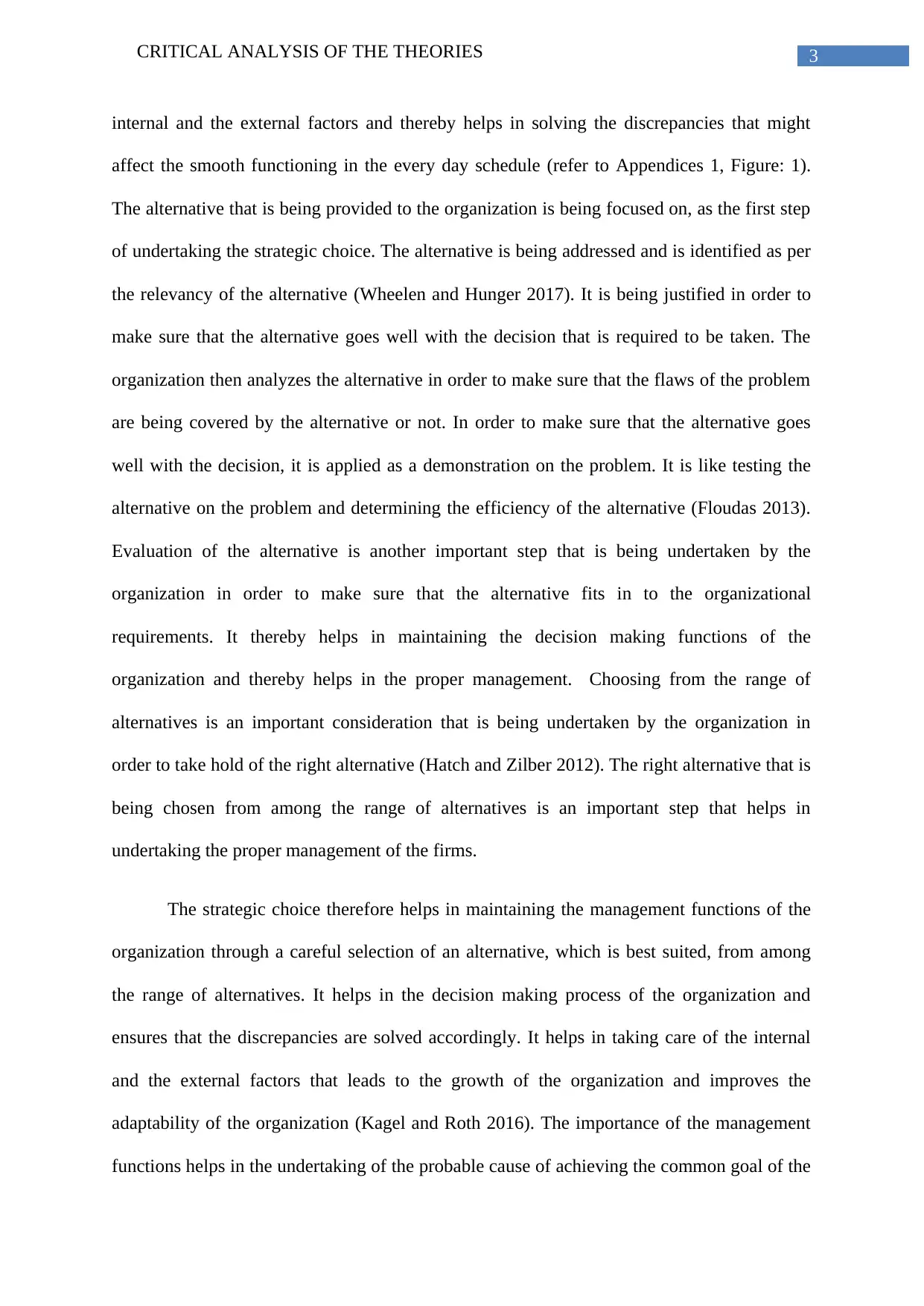
3CRITICAL ANALYSIS OF THE THEORIES
internal and the external factors and thereby helps in solving the discrepancies that might
affect the smooth functioning in the every day schedule (refer to Appendices 1, Figure: 1).
The alternative that is being provided to the organization is being focused on, as the first step
of undertaking the strategic choice. The alternative is being addressed and is identified as per
the relevancy of the alternative (Wheelen and Hunger 2017). It is being justified in order to
make sure that the alternative goes well with the decision that is required to be taken. The
organization then analyzes the alternative in order to make sure that the flaws of the problem
are being covered by the alternative or not. In order to make sure that the alternative goes
well with the decision, it is applied as a demonstration on the problem. It is like testing the
alternative on the problem and determining the efficiency of the alternative (Floudas 2013).
Evaluation of the alternative is another important step that is being undertaken by the
organization in order to make sure that the alternative fits in to the organizational
requirements. It thereby helps in maintaining the decision making functions of the
organization and thereby helps in the proper management. Choosing from the range of
alternatives is an important consideration that is being undertaken by the organization in
order to take hold of the right alternative (Hatch and Zilber 2012). The right alternative that is
being chosen from among the range of alternatives is an important step that helps in
undertaking the proper management of the firms.
The strategic choice therefore helps in maintaining the management functions of the
organization through a careful selection of an alternative, which is best suited, from among
the range of alternatives. It helps in the decision making process of the organization and
ensures that the discrepancies are solved accordingly. It helps in taking care of the internal
and the external factors that leads to the growth of the organization and improves the
adaptability of the organization (Kagel and Roth 2016). The importance of the management
functions helps in the undertaking of the probable cause of achieving the common goal of the
internal and the external factors and thereby helps in solving the discrepancies that might
affect the smooth functioning in the every day schedule (refer to Appendices 1, Figure: 1).
The alternative that is being provided to the organization is being focused on, as the first step
of undertaking the strategic choice. The alternative is being addressed and is identified as per
the relevancy of the alternative (Wheelen and Hunger 2017). It is being justified in order to
make sure that the alternative goes well with the decision that is required to be taken. The
organization then analyzes the alternative in order to make sure that the flaws of the problem
are being covered by the alternative or not. In order to make sure that the alternative goes
well with the decision, it is applied as a demonstration on the problem. It is like testing the
alternative on the problem and determining the efficiency of the alternative (Floudas 2013).
Evaluation of the alternative is another important step that is being undertaken by the
organization in order to make sure that the alternative fits in to the organizational
requirements. It thereby helps in maintaining the decision making functions of the
organization and thereby helps in the proper management. Choosing from the range of
alternatives is an important consideration that is being undertaken by the organization in
order to take hold of the right alternative (Hatch and Zilber 2012). The right alternative that is
being chosen from among the range of alternatives is an important step that helps in
undertaking the proper management of the firms.
The strategic choice therefore helps in maintaining the management functions of the
organization through a careful selection of an alternative, which is best suited, from among
the range of alternatives. It helps in the decision making process of the organization and
ensures that the discrepancies are solved accordingly. It helps in taking care of the internal
and the external factors that leads to the growth of the organization and improves the
adaptability of the organization (Kagel and Roth 2016). The importance of the management
functions helps in the undertaking of the probable cause of achieving the common goal of the
Paraphrase This Document
Need a fresh take? Get an instant paraphrase of this document with our AI Paraphraser
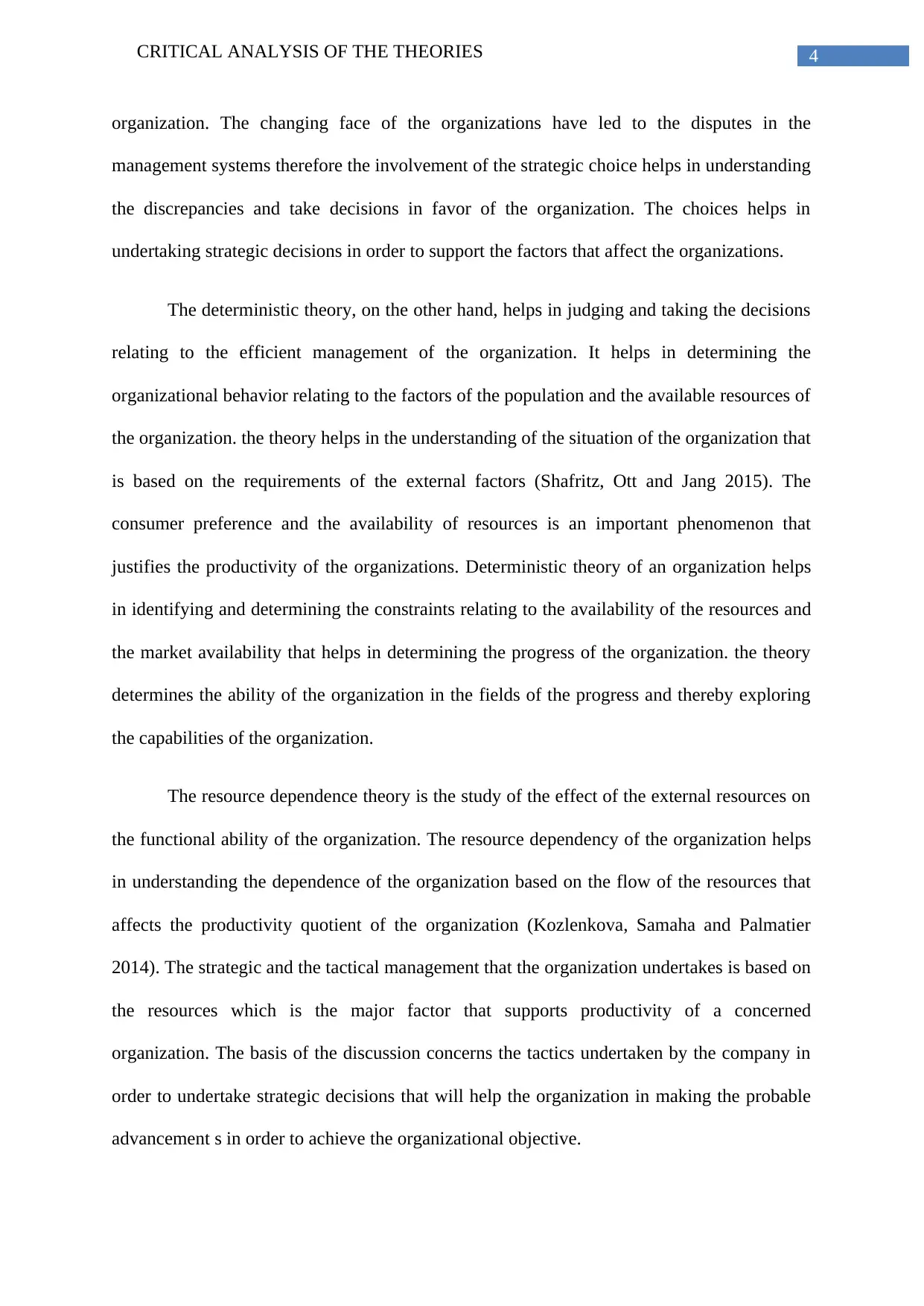
4CRITICAL ANALYSIS OF THE THEORIES
organization. The changing face of the organizations have led to the disputes in the
management systems therefore the involvement of the strategic choice helps in understanding
the discrepancies and take decisions in favor of the organization. The choices helps in
undertaking strategic decisions in order to support the factors that affect the organizations.
The deterministic theory, on the other hand, helps in judging and taking the decisions
relating to the efficient management of the organization. It helps in determining the
organizational behavior relating to the factors of the population and the available resources of
the organization. the theory helps in the understanding of the situation of the organization that
is based on the requirements of the external factors (Shafritz, Ott and Jang 2015). The
consumer preference and the availability of resources is an important phenomenon that
justifies the productivity of the organizations. Deterministic theory of an organization helps
in identifying and determining the constraints relating to the availability of the resources and
the market availability that helps in determining the progress of the organization. the theory
determines the ability of the organization in the fields of the progress and thereby exploring
the capabilities of the organization.
The resource dependence theory is the study of the effect of the external resources on
the functional ability of the organization. The resource dependency of the organization helps
in understanding the dependence of the organization based on the flow of the resources that
affects the productivity quotient of the organization (Kozlenkova, Samaha and Palmatier
2014). The strategic and the tactical management that the organization undertakes is based on
the resources which is the major factor that supports productivity of a concerned
organization. The basis of the discussion concerns the tactics undertaken by the company in
order to undertake strategic decisions that will help the organization in making the probable
advancement s in order to achieve the organizational objective.
organization. The changing face of the organizations have led to the disputes in the
management systems therefore the involvement of the strategic choice helps in understanding
the discrepancies and take decisions in favor of the organization. The choices helps in
undertaking strategic decisions in order to support the factors that affect the organizations.
The deterministic theory, on the other hand, helps in judging and taking the decisions
relating to the efficient management of the organization. It helps in determining the
organizational behavior relating to the factors of the population and the available resources of
the organization. the theory helps in the understanding of the situation of the organization that
is based on the requirements of the external factors (Shafritz, Ott and Jang 2015). The
consumer preference and the availability of resources is an important phenomenon that
justifies the productivity of the organizations. Deterministic theory of an organization helps
in identifying and determining the constraints relating to the availability of the resources and
the market availability that helps in determining the progress of the organization. the theory
determines the ability of the organization in the fields of the progress and thereby exploring
the capabilities of the organization.
The resource dependence theory is the study of the effect of the external resources on
the functional ability of the organization. The resource dependency of the organization helps
in understanding the dependence of the organization based on the flow of the resources that
affects the productivity quotient of the organization (Kozlenkova, Samaha and Palmatier
2014). The strategic and the tactical management that the organization undertakes is based on
the resources which is the major factor that supports productivity of a concerned
organization. The basis of the discussion concerns the tactics undertaken by the company in
order to undertake strategic decisions that will help the organization in making the probable
advancement s in order to achieve the organizational objective.
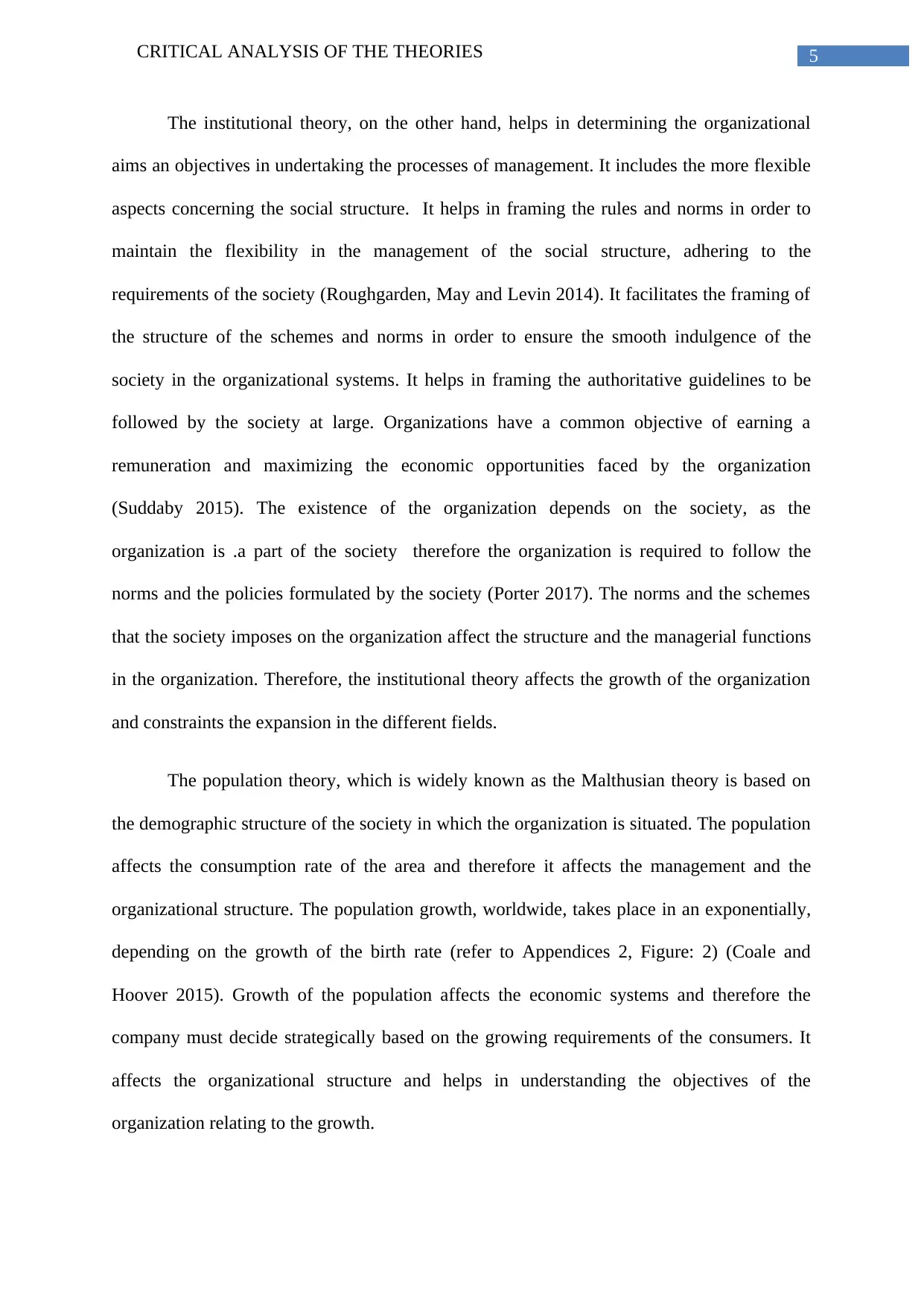
5CRITICAL ANALYSIS OF THE THEORIES
The institutional theory, on the other hand, helps in determining the organizational
aims an objectives in undertaking the processes of management. It includes the more flexible
aspects concerning the social structure. It helps in framing the rules and norms in order to
maintain the flexibility in the management of the social structure, adhering to the
requirements of the society (Roughgarden, May and Levin 2014). It facilitates the framing of
the structure of the schemes and norms in order to ensure the smooth indulgence of the
society in the organizational systems. It helps in framing the authoritative guidelines to be
followed by the society at large. Organizations have a common objective of earning a
remuneration and maximizing the economic opportunities faced by the organization
(Suddaby 2015). The existence of the organization depends on the society, as the
organization is .a part of the society therefore the organization is required to follow the
norms and the policies formulated by the society (Porter 2017). The norms and the schemes
that the society imposes on the organization affect the structure and the managerial functions
in the organization. Therefore, the institutional theory affects the growth of the organization
and constraints the expansion in the different fields.
The population theory, which is widely known as the Malthusian theory is based on
the demographic structure of the society in which the organization is situated. The population
affects the consumption rate of the area and therefore it affects the management and the
organizational structure. The population growth, worldwide, takes place in an exponentially,
depending on the growth of the birth rate (refer to Appendices 2, Figure: 2) (Coale and
Hoover 2015). Growth of the population affects the economic systems and therefore the
company must decide strategically based on the growing requirements of the consumers. It
affects the organizational structure and helps in understanding the objectives of the
organization relating to the growth.
The institutional theory, on the other hand, helps in determining the organizational
aims an objectives in undertaking the processes of management. It includes the more flexible
aspects concerning the social structure. It helps in framing the rules and norms in order to
maintain the flexibility in the management of the social structure, adhering to the
requirements of the society (Roughgarden, May and Levin 2014). It facilitates the framing of
the structure of the schemes and norms in order to ensure the smooth indulgence of the
society in the organizational systems. It helps in framing the authoritative guidelines to be
followed by the society at large. Organizations have a common objective of earning a
remuneration and maximizing the economic opportunities faced by the organization
(Suddaby 2015). The existence of the organization depends on the society, as the
organization is .a part of the society therefore the organization is required to follow the
norms and the policies formulated by the society (Porter 2017). The norms and the schemes
that the society imposes on the organization affect the structure and the managerial functions
in the organization. Therefore, the institutional theory affects the growth of the organization
and constraints the expansion in the different fields.
The population theory, which is widely known as the Malthusian theory is based on
the demographic structure of the society in which the organization is situated. The population
affects the consumption rate of the area and therefore it affects the management and the
organizational structure. The population growth, worldwide, takes place in an exponentially,
depending on the growth of the birth rate (refer to Appendices 2, Figure: 2) (Coale and
Hoover 2015). Growth of the population affects the economic systems and therefore the
company must decide strategically based on the growing requirements of the consumers. It
affects the organizational structure and helps in understanding the objectives of the
organization relating to the growth.
⊘ This is a preview!⊘
Do you want full access?
Subscribe today to unlock all pages.

Trusted by 1+ million students worldwide
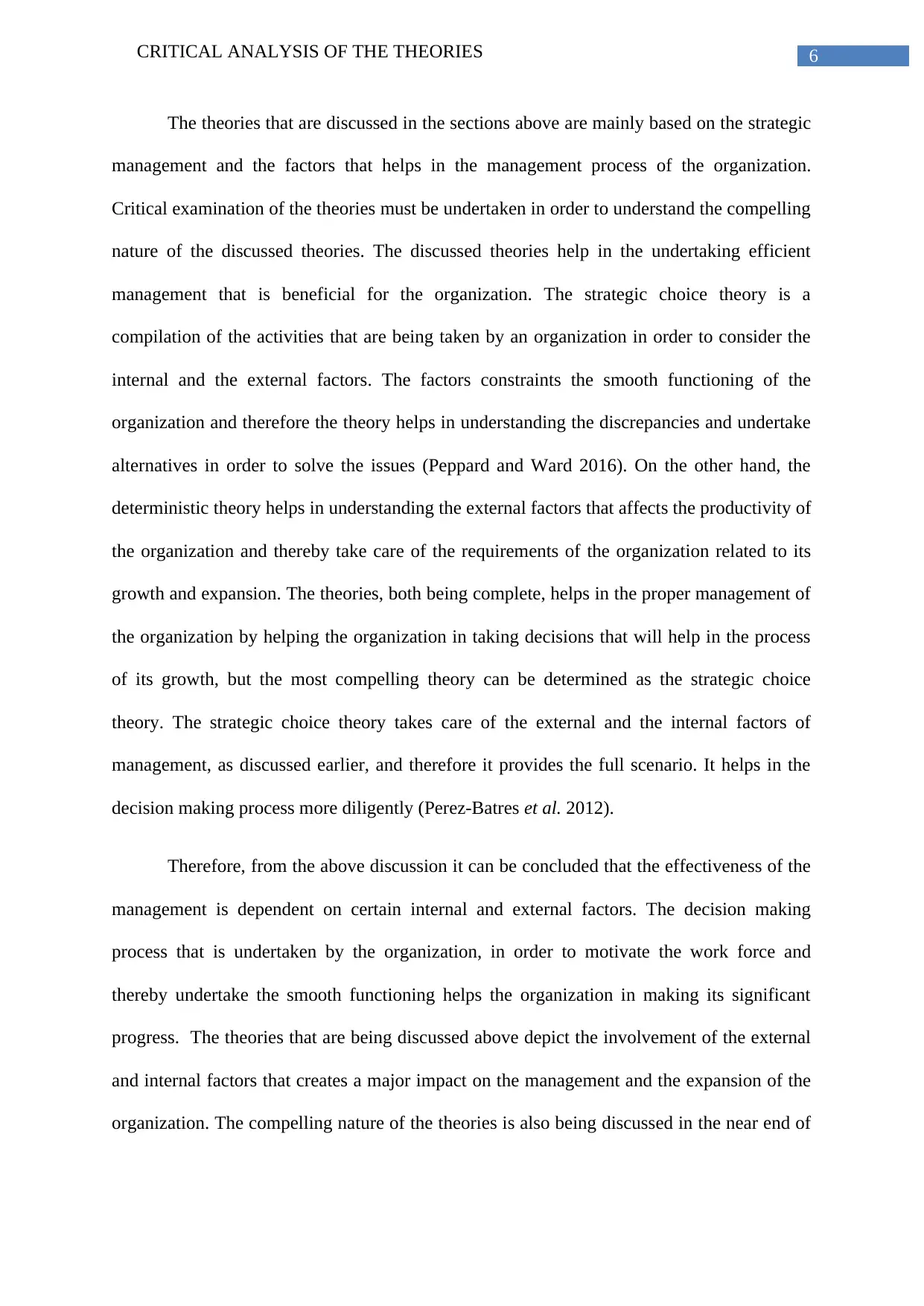
6CRITICAL ANALYSIS OF THE THEORIES
The theories that are discussed in the sections above are mainly based on the strategic
management and the factors that helps in the management process of the organization.
Critical examination of the theories must be undertaken in order to understand the compelling
nature of the discussed theories. The discussed theories help in the undertaking efficient
management that is beneficial for the organization. The strategic choice theory is a
compilation of the activities that are being taken by an organization in order to consider the
internal and the external factors. The factors constraints the smooth functioning of the
organization and therefore the theory helps in understanding the discrepancies and undertake
alternatives in order to solve the issues (Peppard and Ward 2016). On the other hand, the
deterministic theory helps in understanding the external factors that affects the productivity of
the organization and thereby take care of the requirements of the organization related to its
growth and expansion. The theories, both being complete, helps in the proper management of
the organization by helping the organization in taking decisions that will help in the process
of its growth, but the most compelling theory can be determined as the strategic choice
theory. The strategic choice theory takes care of the external and the internal factors of
management, as discussed earlier, and therefore it provides the full scenario. It helps in the
decision making process more diligently (Perez-Batres et al. 2012).
Therefore, from the above discussion it can be concluded that the effectiveness of the
management is dependent on certain internal and external factors. The decision making
process that is undertaken by the organization, in order to motivate the work force and
thereby undertake the smooth functioning helps the organization in making its significant
progress. The theories that are being discussed above depict the involvement of the external
and internal factors that creates a major impact on the management and the expansion of the
organization. The compelling nature of the theories is also being discussed in the near end of
The theories that are discussed in the sections above are mainly based on the strategic
management and the factors that helps in the management process of the organization.
Critical examination of the theories must be undertaken in order to understand the compelling
nature of the discussed theories. The discussed theories help in the undertaking efficient
management that is beneficial for the organization. The strategic choice theory is a
compilation of the activities that are being taken by an organization in order to consider the
internal and the external factors. The factors constraints the smooth functioning of the
organization and therefore the theory helps in understanding the discrepancies and undertake
alternatives in order to solve the issues (Peppard and Ward 2016). On the other hand, the
deterministic theory helps in understanding the external factors that affects the productivity of
the organization and thereby take care of the requirements of the organization related to its
growth and expansion. The theories, both being complete, helps in the proper management of
the organization by helping the organization in taking decisions that will help in the process
of its growth, but the most compelling theory can be determined as the strategic choice
theory. The strategic choice theory takes care of the external and the internal factors of
management, as discussed earlier, and therefore it provides the full scenario. It helps in the
decision making process more diligently (Perez-Batres et al. 2012).
Therefore, from the above discussion it can be concluded that the effectiveness of the
management is dependent on certain internal and external factors. The decision making
process that is undertaken by the organization, in order to motivate the work force and
thereby undertake the smooth functioning helps the organization in making its significant
progress. The theories that are being discussed above depict the involvement of the external
and internal factors that creates a major impact on the management and the expansion of the
organization. The compelling nature of the theories is also being discussed in the near end of
Paraphrase This Document
Need a fresh take? Get an instant paraphrase of this document with our AI Paraphraser
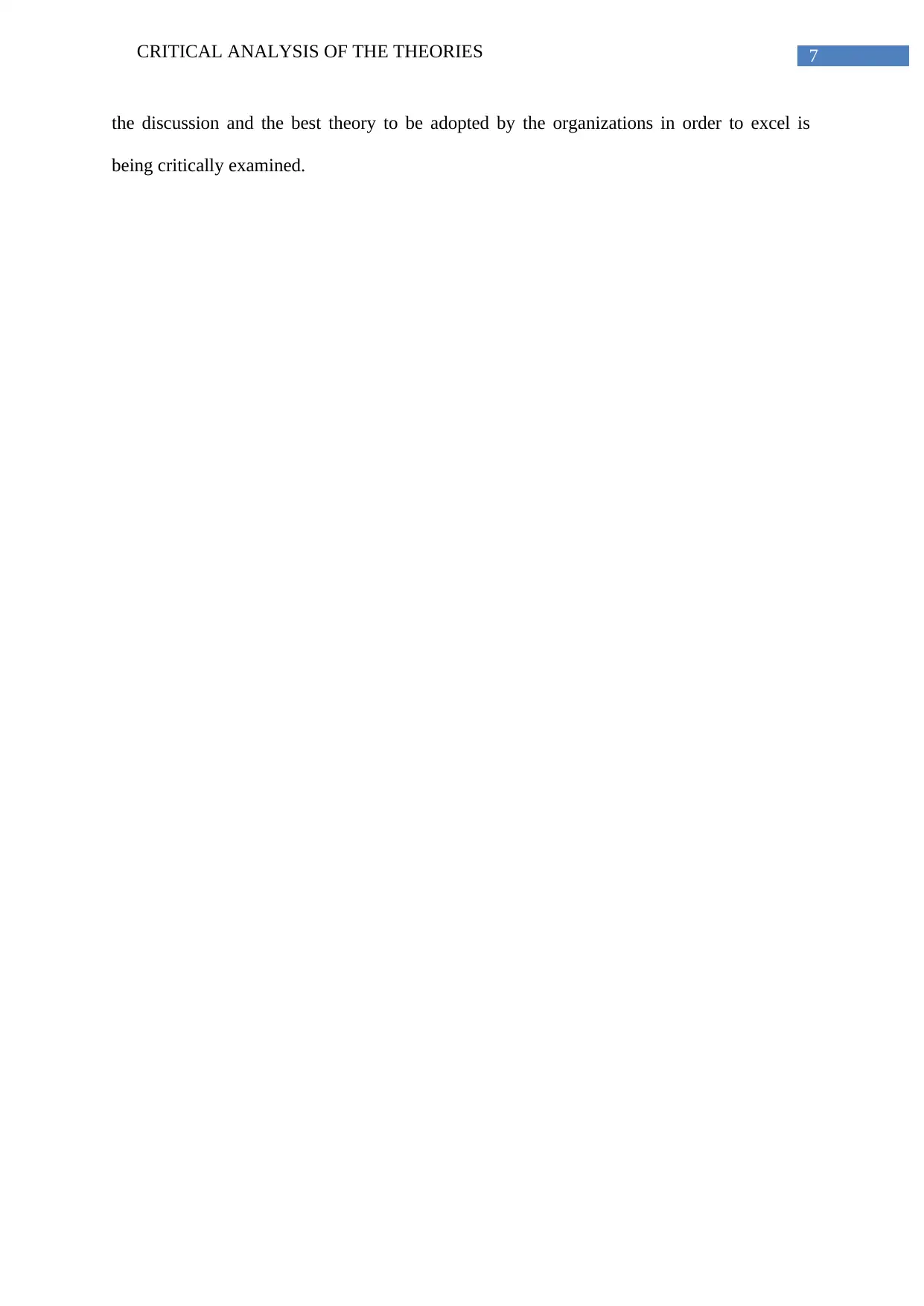
7CRITICAL ANALYSIS OF THE THEORIES
the discussion and the best theory to be adopted by the organizations in order to excel is
being critically examined.
the discussion and the best theory to be adopted by the organizations in order to excel is
being critically examined.
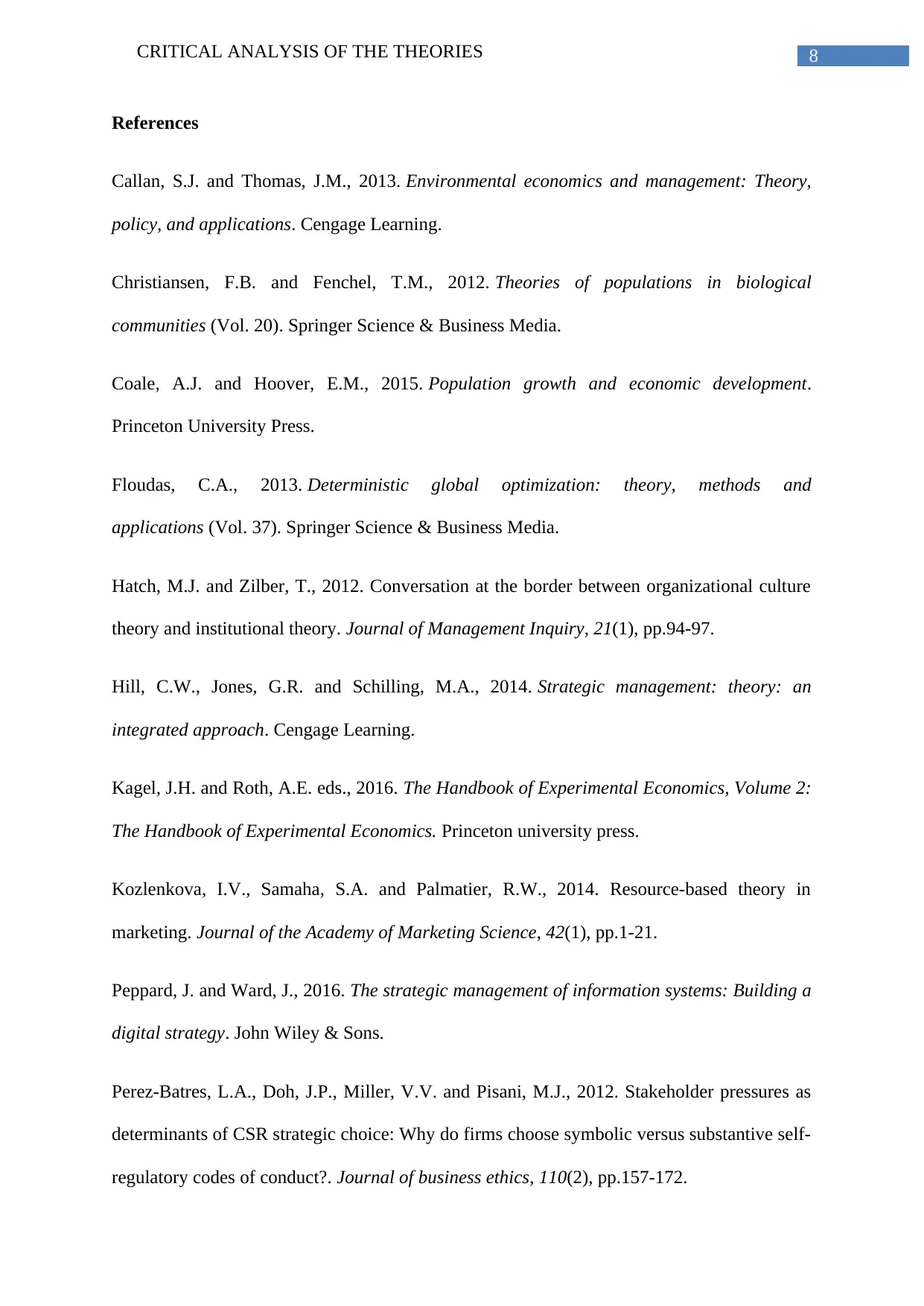
8CRITICAL ANALYSIS OF THE THEORIES
References
Callan, S.J. and Thomas, J.M., 2013. Environmental economics and management: Theory,
policy, and applications. Cengage Learning.
Christiansen, F.B. and Fenchel, T.M., 2012. Theories of populations in biological
communities (Vol. 20). Springer Science & Business Media.
Coale, A.J. and Hoover, E.M., 2015. Population growth and economic development.
Princeton University Press.
Floudas, C.A., 2013. Deterministic global optimization: theory, methods and
applications (Vol. 37). Springer Science & Business Media.
Hatch, M.J. and Zilber, T., 2012. Conversation at the border between organizational culture
theory and institutional theory. Journal of Management Inquiry, 21(1), pp.94-97.
Hill, C.W., Jones, G.R. and Schilling, M.A., 2014. Strategic management: theory: an
integrated approach. Cengage Learning.
Kagel, J.H. and Roth, A.E. eds., 2016. The Handbook of Experimental Economics, Volume 2:
The Handbook of Experimental Economics. Princeton university press.
Kozlenkova, I.V., Samaha, S.A. and Palmatier, R.W., 2014. Resource-based theory in
marketing. Journal of the Academy of Marketing Science, 42(1), pp.1-21.
Peppard, J. and Ward, J., 2016. The strategic management of information systems: Building a
digital strategy. John Wiley & Sons.
Perez-Batres, L.A., Doh, J.P., Miller, V.V. and Pisani, M.J., 2012. Stakeholder pressures as
determinants of CSR strategic choice: Why do firms choose symbolic versus substantive self-
regulatory codes of conduct?. Journal of business ethics, 110(2), pp.157-172.
References
Callan, S.J. and Thomas, J.M., 2013. Environmental economics and management: Theory,
policy, and applications. Cengage Learning.
Christiansen, F.B. and Fenchel, T.M., 2012. Theories of populations in biological
communities (Vol. 20). Springer Science & Business Media.
Coale, A.J. and Hoover, E.M., 2015. Population growth and economic development.
Princeton University Press.
Floudas, C.A., 2013. Deterministic global optimization: theory, methods and
applications (Vol. 37). Springer Science & Business Media.
Hatch, M.J. and Zilber, T., 2012. Conversation at the border between organizational culture
theory and institutional theory. Journal of Management Inquiry, 21(1), pp.94-97.
Hill, C.W., Jones, G.R. and Schilling, M.A., 2014. Strategic management: theory: an
integrated approach. Cengage Learning.
Kagel, J.H. and Roth, A.E. eds., 2016. The Handbook of Experimental Economics, Volume 2:
The Handbook of Experimental Economics. Princeton university press.
Kozlenkova, I.V., Samaha, S.A. and Palmatier, R.W., 2014. Resource-based theory in
marketing. Journal of the Academy of Marketing Science, 42(1), pp.1-21.
Peppard, J. and Ward, J., 2016. The strategic management of information systems: Building a
digital strategy. John Wiley & Sons.
Perez-Batres, L.A., Doh, J.P., Miller, V.V. and Pisani, M.J., 2012. Stakeholder pressures as
determinants of CSR strategic choice: Why do firms choose symbolic versus substantive self-
regulatory codes of conduct?. Journal of business ethics, 110(2), pp.157-172.
⊘ This is a preview!⊘
Do you want full access?
Subscribe today to unlock all pages.

Trusted by 1+ million students worldwide
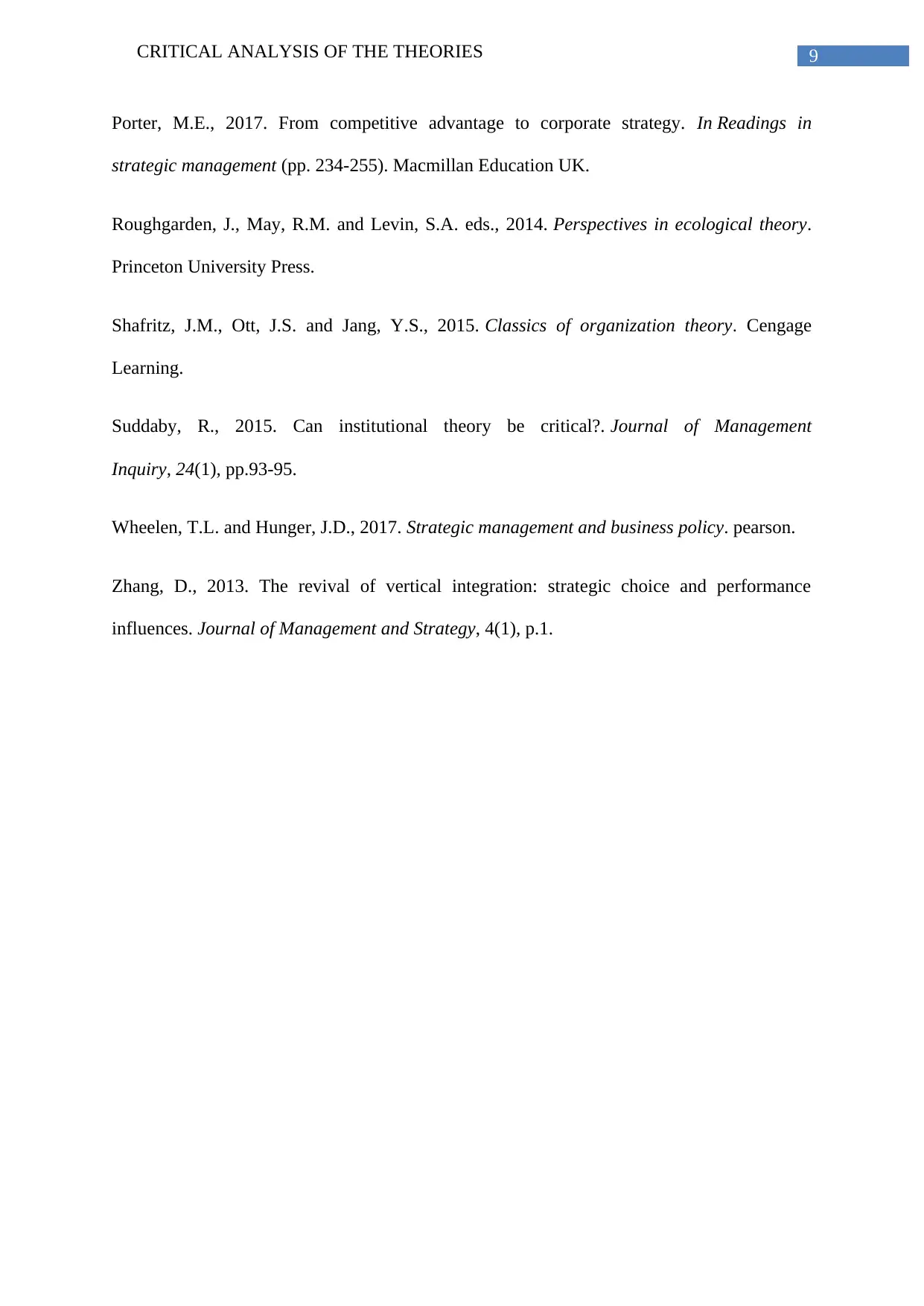
9CRITICAL ANALYSIS OF THE THEORIES
Porter, M.E., 2017. From competitive advantage to corporate strategy. In Readings in
strategic management (pp. 234-255). Macmillan Education UK.
Roughgarden, J., May, R.M. and Levin, S.A. eds., 2014. Perspectives in ecological theory.
Princeton University Press.
Shafritz, J.M., Ott, J.S. and Jang, Y.S., 2015. Classics of organization theory. Cengage
Learning.
Suddaby, R., 2015. Can institutional theory be critical?. Journal of Management
Inquiry, 24(1), pp.93-95.
Wheelen, T.L. and Hunger, J.D., 2017. Strategic management and business policy. pearson.
Zhang, D., 2013. The revival of vertical integration: strategic choice and performance
influences. Journal of Management and Strategy, 4(1), p.1.
Porter, M.E., 2017. From competitive advantage to corporate strategy. In Readings in
strategic management (pp. 234-255). Macmillan Education UK.
Roughgarden, J., May, R.M. and Levin, S.A. eds., 2014. Perspectives in ecological theory.
Princeton University Press.
Shafritz, J.M., Ott, J.S. and Jang, Y.S., 2015. Classics of organization theory. Cengage
Learning.
Suddaby, R., 2015. Can institutional theory be critical?. Journal of Management
Inquiry, 24(1), pp.93-95.
Wheelen, T.L. and Hunger, J.D., 2017. Strategic management and business policy. pearson.
Zhang, D., 2013. The revival of vertical integration: strategic choice and performance
influences. Journal of Management and Strategy, 4(1), p.1.
Paraphrase This Document
Need a fresh take? Get an instant paraphrase of this document with our AI Paraphraser
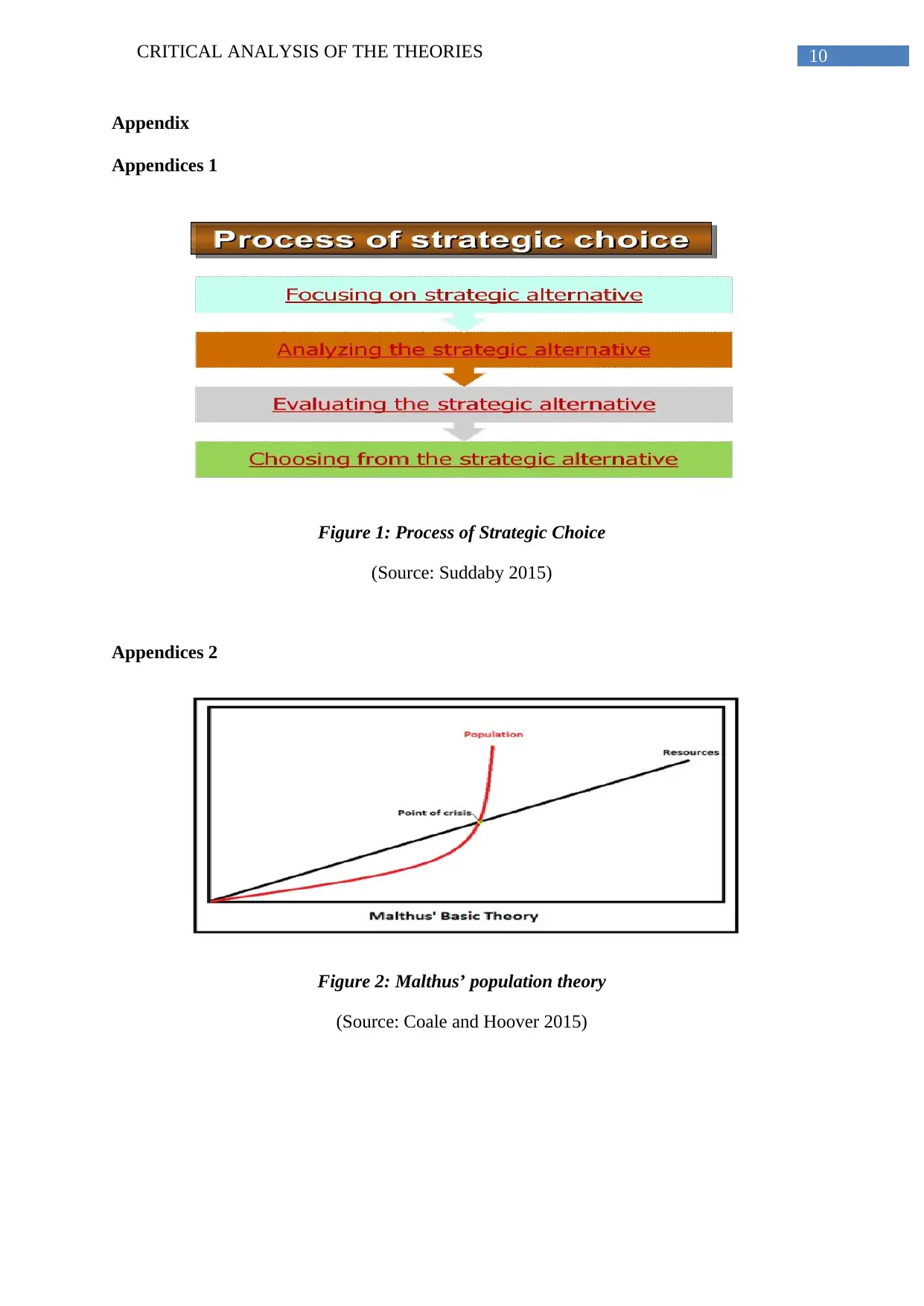
10CRITICAL ANALYSIS OF THE THEORIES
Appendix
Appendices 1
Figure 1: Process of Strategic Choice
(Source: Suddaby 2015)
Appendices 2
Figure 2: Malthus’ population theory
(Source: Coale and Hoover 2015)
Appendix
Appendices 1
Figure 1: Process of Strategic Choice
(Source: Suddaby 2015)
Appendices 2
Figure 2: Malthus’ population theory
(Source: Coale and Hoover 2015)
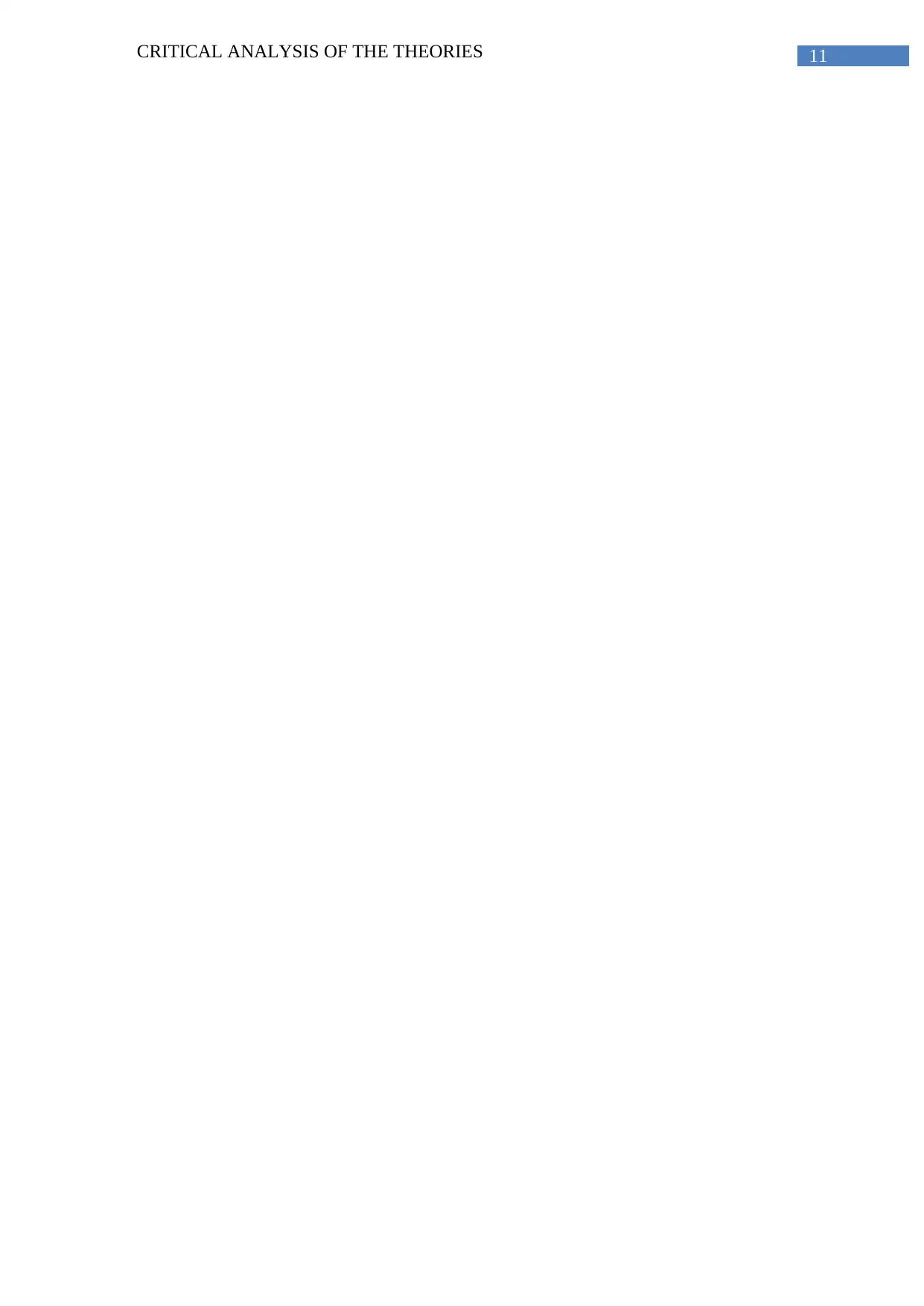
11CRITICAL ANALYSIS OF THE THEORIES
⊘ This is a preview!⊘
Do you want full access?
Subscribe today to unlock all pages.

Trusted by 1+ million students worldwide
1 out of 12
Related Documents
Your All-in-One AI-Powered Toolkit for Academic Success.
+13062052269
info@desklib.com
Available 24*7 on WhatsApp / Email
![[object Object]](/_next/static/media/star-bottom.7253800d.svg)
Unlock your academic potential
Copyright © 2020–2025 A2Z Services. All Rights Reserved. Developed and managed by ZUCOL.





